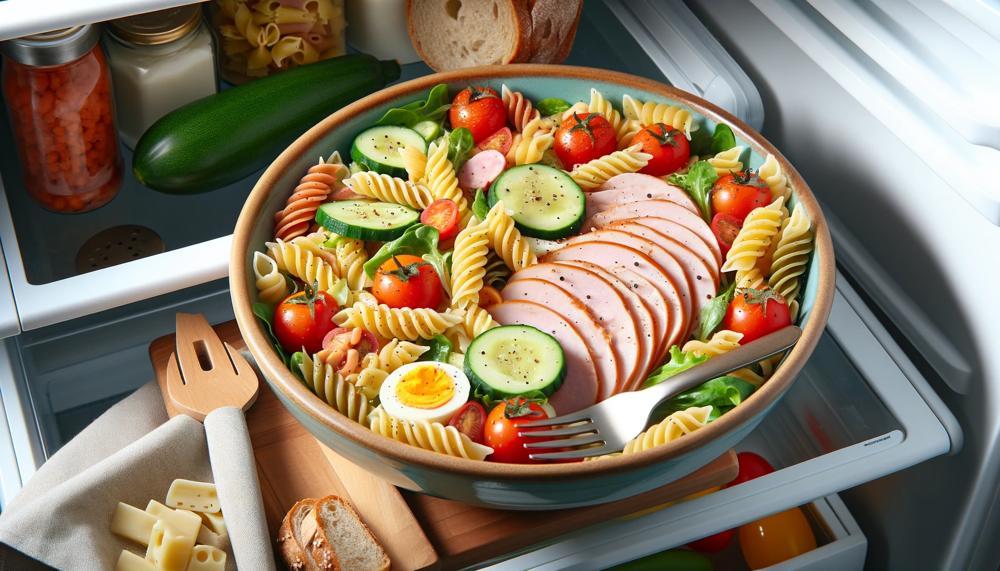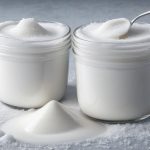When it comes to storing pasta salad in the fridge, many factors can affect its shelf life. From the ingredients used to the type of containers used for storage, it’s important to understand the best practices to ensure the freshness and safety of your pasta salad. In this article, I will discuss the various factors that influence the shelf life of pasta salad, the best ingredients and dressings for longer-lasting salads, proper storage techniques, tips for serving and refreshing, and the signs of spoilage to watch out for.
Contents
- 1 How Long Does Pasta Salad Last In the Fridge?
- 2 Factors Affecting Shelf Life of Pasta Salad
- 3 Best Ingredients and Dressings for Longer-lasting Pasta Salad
- 4 Proper Storage Techniques for Pasta Salad
- 5 Tips for Serving and Refreshing Pasta Salad
- 6 Signs of Spoilage in Pasta Salad
- 7 Conclusion
- 8 Source Links
Key Takeaways:
- Pasta salad can last 4 to 7 days in the fridge when stored correctly.
- Factors such as ingredients, room temperature exposure, and container type can affect the shelf life of pasta salad.
- Pasta salads without meat or dairy tend to last longer in the fridge.
- Using sealed containers or freezer-quality bags can help prolong the freshness of pasta salad.
- Choose ingredients and dressings that are less prone to spoilage, such as dried pasta and oil-based dressings like Italian or pesto.
How Long Does Pasta Salad Last In the Fridge?
If kept correctly in an airtight container, pasta salad can keep in the refrigerator for three to five days. But after the first few days, the taste and texture could start to lose their appeal. This is due to the fact that over time, items such as herbs and vegetables may lose their freshness and hence lose some of their taste.

Make sure your pasta salad is well sealed and that there is as little surplus air in the container as possible to ensure a long shelf life.
Additionally, leftover pasta salad keeps for up to three months in the freezer.
Factors Affecting Shelf Life of Pasta Salad
The shelf life of pasta salad can vary depending on several factors. It’s essential to consider these factors to ensure the salad stays fresh and safe to consume. The ingredients used in the salad play a significant role in determining its shelf life. Ingredients such as meat or dairy can shorten the salad’s lifespan, as they are more susceptible to bacterial growth.
Avoiding these ingredients or opting for meat alternatives can help prolong the shelf life of the salad. Additionally, the temperature at which the salad is stored is crucial. Leaving pasta salad at room temperature for an extended period can lead to the rapid growth of bacteria.
It is important to refrigerate pasta salad promptly after preparation to prevent bacterial contamination. The temperature danger zone, which ranges from 40-140 degrees Fahrenheit, is where bacteria multiply the fastest, so refrigeration is paramount.
The type of container used to store the pasta salad also affects its shelf life. Sealed containers or freezer-quality bags are recommended for optimal freshness. These containers help prevent air and moisture from seeping in, which can accelerate spoilage. Proper container selection can significantly extend the shelf life of pasta salad.
Another factor to consider is the inclusion of vegetables with high water content in the salad. Vegetables such as lettuce, cherry tomatoes, or cucumbers release moisture, causing the salad to become soggy. Adding these vegetables shortly before serving or storing them separately can help maintain the salad’s texture and avoid sogginess.
By taking these factors into account and following proper storage practices, pasta salad can typically last for about 4 to 7 days in the refrigerator. The freshness and quality of the salad can be maintained by considering the ingredients used, refrigerating promptly, using appropriate containers, and managing vegetable moisture content.
Best Ingredients and Dressings for Longer-lasting Pasta Salad
Choosing the right ingredients and dressings is essential for maximizing the shelf life of pasta salad. By selecting the appropriate components, you can ensure that your pasta salad remains fresh and flavorful for a longer duration.
When it comes to the pasta itself, opt for dried varieties rather than fresh pasta. Dried pasta holds its texture better when combined with other ingredients, preventing it from becoming too soft or mushy over time. Small pasta shapes like farfalle, fusilli, or rotini work exceptionally well in pasta salads. Their unique shape allows them to capture dressings and vegetables, enhancing the overall taste experience with each bite.
When adding vegetables to your pasta salad, choose fresh options like red onions, bell peppers, black olives, and roasted artichoke hearts. These vegetables add a delightful crunch and flavor to the salad. However, it is important to avoid vegetables with high water content, as they can cause the salad to become soggy. By carefully selecting your vegetable ingredients, you can maintain the desired consistency and texture of the salad for an extended period.
When it comes to dressings, it is advisable to opt for oil-based options such as Italian dressing or pesto. Oil-based dressings tend to have a longer shelf life compared to creamy dressings, which can degrade faster. Alternatively, you can use high-quality olive oil and fresh lemon juice as a dressing alternative. This combination not only adds a refreshing citrusy note but also helps in preserving the freshness of the salad for a more extended period.
Proper Storage Techniques for Pasta Salad
When it comes to maintaining the freshness of your pasta salad, proper storage techniques are essential. Follow these guidelines to ensure that your pasta salad stays flavorful and delicious.
Use Airtight Containers
Store your pasta salad in airtight containers or heavy-duty storage bags to keep it well-sealed and protected from air and moisture. This will help prevent the salad from becoming dry or soggy.
Prep Ingredients Separately
If you’re preparing your pasta salad ahead of time, consider prepping the ingredients separately and mixing them together just before serving. This will prevent the salad from becoming too moist and losing its desirable texture.
Storage Time
Leftover pasta salad can be stored in the fridge for 3-5 days. Make sure to consume it within this time frame to ensure its freshness and quality. If you have more pasta salad than you can consume within a few days, you can freeze the leftovers.
Freezing Pasta Salad
Pasta salad can be frozen for up to 3 months. However, it’s important to use freezer bags or airtight plastic containers to avoid freezer burn.
Avoid Dairy-based Dressings for Freezing
Keep in mind that pasta salads with dairy-based dressings may experience changes in texture after freezing. To avoid any unpleasant changes, it’s best to choose dressings without dairy when planning to freeze your pasta salad.
Proper Storage Tips Recap
- Use airtight containers or heavy-duty storage bags
- Prep ingredients separately and mix just before serving
- Store in the fridge for 3-5 days
- Freeze for up to 3 months using freezer bags or airtight containers
- Choose dressings without dairy for freezing
By following these proper storage techniques, you can enjoy your pasta salad at its best for an extended period of time.
| Storage Technique | Benefits |
|---|---|
| Using airtight containers | Prevents air and moisture from affecting the salad’s quality |
| Prepping ingredients separately | Maintains the salad’s desired texture and prevents moisture accumulation |
| Storage in the fridge | Keeps the salad fresh for up to 5 days |
| Freezing in freezer bags or airtight containers | Extends the shelf life to up to 3 months |
| Avoiding dairy-based dressings for freezing | Prevents undesirable changes in texture |
Tips for Serving and Refreshing Pasta Salad
To ensure the best taste and freshness when serving pasta salad, it is important to follow proper serving and refreshing techniques.
- Avoid leaving the salad outside for an extended period, especially in warm temperatures, as it can spoil quickly.
- If serving pasta salad outdoors, cover the dish with plastic wrap and place it in a shaded area away from direct sunlight to keep it cool and prevent bacterial growth.
- When preparing the pasta for the salad, cook it al dente to maintain a firm texture that can absorb the dressing without becoming mushy.
- If the pasta salad becomes soggy after storing, it may be due to overcooking the pasta. Adding more dressing can help moisten it and revive its flavors.
- To keep the pasta salad fresh until serving, it is advisable to mix only the desired amount of salad and dressing for each serving, keeping the remaining pasta and ingredients separate until ready to eat.
By following these tips, you can ensure that your pasta salad is served at its best, with optimal taste and texture.
Signs of Spoilage in Pasta Salad
When it comes to pasta salad, it’s crucial to recognize the signs of spoilage to ensure food safety. Here are some common signs to watch out for:
- Sour Smell: If your pasta salad has a sour or unpleasant odor, it could be a sign that it has gone bad.
- Changes in Texture: Sliminess or gooiness in the pasta salad can indicate spoilage. If the texture seems off, it’s best to discard it.
- Changes in Color: Any visible changes in the color of the salad, such as browning or discoloration, may signify spoilage.
- Presence of Mold: If you spot mold on the pasta salad, it’s a definite indication that it has spoiled. Even if the mold is present only in a small area, it’s best to avoid consuming the entire dish as mold spores can spread throughout.
If any of these signs are present in your pasta salad, it’s important to err on the side of caution and avoid consuming it. This is especially true for pre-made pasta salads bought from stores, as they may still be within the expiration date but can harbor spoilage signs. Consuming spoiled pasta salad puts you at risk of food poisoning, so it’s better to be safe than sorry.
Also Read: When Does Peanut Oil Go Bad?
Conclusion
Proper storage, ingredient selection, and serving techniques are key factors in determining the shelf life of pasta salad. By following the guidelines outlined in this article, pasta salad can stay fresh in the fridge for about 4 to 7 days when stored correctly. Factors such as ingredients, room temperature exposure, and container type all play a role in the salad’s shelf life.
Pay attention to signs of spoilage to ensure food safety and avoid consuming pasta salad that has gone bad. Refreshing techniques can help revive the flavors and textures of leftover pasta salad. With the right knowledge and precautions, you can enjoy delicious pasta salad for several days while maintaining its freshness and quality.
Source Links
- https://www.cucinabyelena.com/how-long-does-pasta-salad-last-in-the-fridge/
- https://www.tastingtable.com/1332734/how-long-pasta-salad-lasts-fridge/
- https://www.nogettingoffthistrain.com/food-tips/how-long-does-pasta-salad-last-in-the-fridge/




